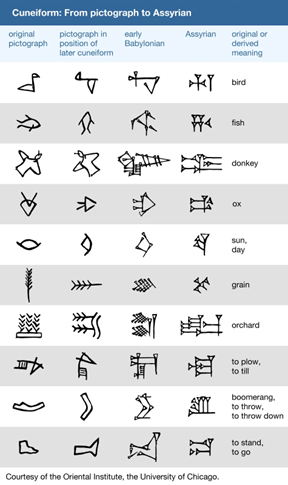History of Writing

Oh the Gutenberg Press, how beautiful art thou, majestic and grand. The demon-child of the guillotine and an uncomfortable massage table, thou art. - A poet

This hallowed World Wide Web, where Break so beautifully weaves its musings, is not the first of its kind. Nay, once upon a time, people read from books, and before that, mysteriously good wall paintings. Evolution aside, cavemen could paint better than most can these days, and dare I say it, even modern art could learn from them. So how did we get from pictures of cows flocking to the sun to the drivel that all too many (including yours truly) enjoy posting on the internet? In my first history blog, I shall provide all the answers I could derive from the interweb so that you may be entertained by my boredom…
First was picture writing, and it is thus no surprise that as children we tend to enjoy picture books more. Perhaps that says something about those who read graphic novels? Out of the dark ages, into the days before air-conditioning, came word-based writing systems (basically just symbols that represent words) then sound-based syllable systems (lines and dashes, sort of like Morse but with much less structure). Sumerian writing, otherwise known as Cuneiform, is a prime example of word-based systems.

But then came the alphabet…
Most, if not all, alphabetic scripts derive from a single ancestor the Semitic alphabet, created some time in the 2nd millennium BCE. The most prominent characteristic is that these languages, such as Hebrew and Arabic, have graphs for consonants but not vowels. However, this absence of vowels leave many ambiguities, which the Greek alphabet fixed between 1000-900 BCE, including both consonants and vowels in the alphabet. If I were to ignore vowels, “ths” could be “this” or “thus”, from which two different meanings can be derived. Greek removed this confusion, though Semitic languages still manage just fine. The Greek alphabet evolved through the widespread adoption of Latin in the Middle Ages as the language of state and scholarship, and the 26 English letters became confirmed in the 26th Century.
But how did my writing get here? Literacy rates remained low for millennia, but in the 21st Century most people can read whatever drivel they like anywhere, anytime. [Enter printing press stage left.]
The first printing press was invented in China, and the first book printed about 868 AD, known as The Diamond Sutra. This press used block printing, which used panels of hand-carved wood blocks in reverse.
Moveable type, which replaced panels of printing blocks with reusable individual letters, was developed by Bi Sheng of China in about 1000 CE, and used clay as the writing surface. 200 years after Sheng’s death, books became prevalent in Chinese society and created a scholarly class of citizens. Huge libraries, much like today, became a status symbol for the wealthy class.
Wang Chen then reintroduced wood into the process in 1297, replacing clay, and mass-produced books like Nung Shu which documented Chinese inventions. This process then became dominant in China for decades.
The famed Gutenberg press was created by Johannes Gutenberg in 1450, which replaced wood with metal and printing blocks with each letter. Gutenberg’s press worked so well because he created his own ink, designed to affix to metal rather than wood, and perfected a method for flattening printing paper with a winepress. His ability to mass produce replica copies was transformative. Gutenberg first printed his Bible in 1452, producing 240 total copies with 50,000 sheets of paper. Johannes Fust funded this project, and acquired the press in 1455 with Peter Schoffer, who was known as a better printed and typographer, putting out a Book of Psalms with three colours on the title page.
Martin Luther, John Calvin and Copernicus soon used the printing press to spread their doctrines much to the dismay of the Church, which promised excommunication of printing without Church permission in 1501. Luther’s 95 Theses were being printed in London merely 17 days after their publication, and his translation of the New Testament sold 5,000 copies in two weeks. Francis Bacon credited the printing press for changing the world in 1620, and philosophic writings by Locke, Voltaire, Rousseau and Paine did just that by partly inspiring revolutions in France and America.
The first newspaper was released in 1605, called Relation, and soon these appeared all over Europe. But, blogs had to wait until 1994 when Justin Hall’s links.net became the first blog. The term ‘weblog’ was first used by Jorn Barger in December 1997, before Open Diary was released the next year, allowing people to comment on the work of others. The term ‘blog’ was first used in 1999, the same year Blogger launched. Heather B Armstrong was the first employee to be fired for blogging about her colleagues in 2002, before Congressional aide Jessica Culter suffered the same fate in 2004. Best hope I don’t start gossiping about my mates on here…
WordPress launched in 2003, and many other blogging platforms followed. Alas, here we are now. Stuck on yet another blog, reading another bit of drivel, but we have literacy to thank for such a struggle. And I guess we can blame Gutenberg, the Greeks and the Chinese some credit for making you, dear readers, sit through my insufferable waffling.
Mwah